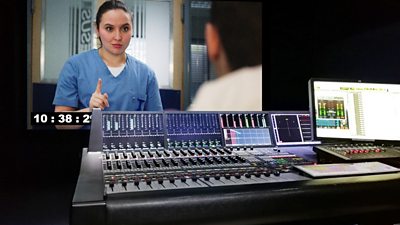
Technological advances in broadcasting can be the impetus for advances in accessibility services. For the eleven million individuals in the United Kingdom with some degree of hearing loss, the advent of object-based broadcasting and its personalisation features has the potential to facilitate a transition towards more accessible broadcast audio.
Part I of this work conducts a systematic review of previous object-based accessibility research, identifying the personalisation of redundant non-speech objects as a potentially high impact yet unexplored area of research. Guided by these findings, and the results of a survey of end-user needs, the specific research questions of this work are then developed as:
- What is the relationship between redundant non-speech audio objects and broadcast speech intelligibility, for normal and hard of hearing listeners?
- Can a system be designed which allows end-users to control the balance between audio objects for dramatic content which is simple to use and preserves comprehension?
Part II of this work shows that the presence of redundant non-speech sounds improves speech recognition in noise in normal-hearing listeners, even when the sound partially masks the speech. Subsequent investigations show that this effect exists within hard of hearing cohorts also, and the benefit yielded by non-speech sounds can be predicted by the severity of hearing loss in an individual's better hearing ear.
Part III of this work translates these novel findings into practical broadcast accessibility technology, through the development of a new conceptual framework called 'Narrative Importance'. Based on this framework, production tools and an end-user interface are developed and deployed in a large scale public trial. The results of this trial demonstrate that this new approach to accessible audio can deliver content which is more enjoyable with reduced energetic masking of speech, whilst still maintaining the creative integrity and comprehension of the content.
This PhD thesis was carried out at the University of Salford and supervised by Ben Shirley and Bill Davies. Parts of the research were undertaken during an internship at Βι¶ΉΤΌΕΔ R&D. It is also .
White Paper copyright
Β© Βι¶ΉΤΌΕΔ. All rights reserved. Except as provided below, no part of a White Paper may be reproduced in any material form (including photocopying or storing it in any medium by electronic means) without the prior written permission of Βι¶ΉΤΌΕΔ Research except in accordance with the provisions of the (UK) Copyright, Designs and Patents Act 1988.
The Βι¶ΉΤΌΕΔ grants permission to individuals and organisations to make copies of any White Paper as a complete document (including the copyright notice) for their own internal use. No copies may be published, distributed or made available to third parties whether by paper, electronic or other means without the Βι¶ΉΤΌΕΔ's prior written permission.